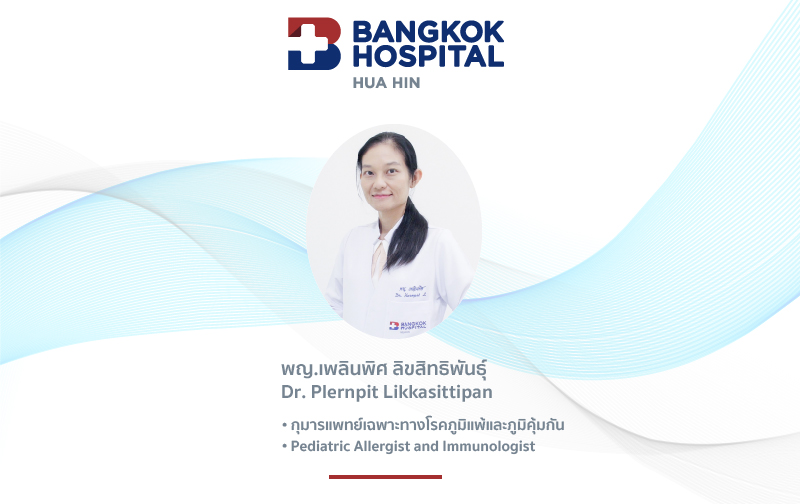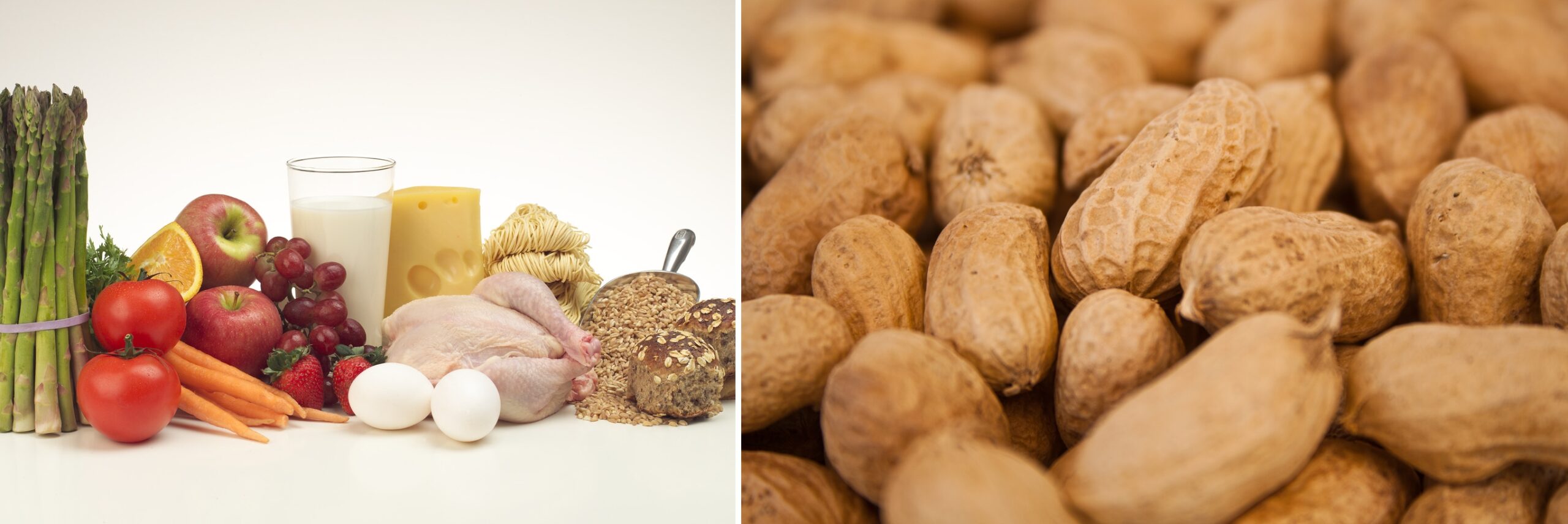“Food Allergies in Children” A Significant Concern That Necessitates Parental Preparation
Food allergies are frequently observed in children, particularly in those under the age of 5. This condition arises when the body’s immune system reacts abnormally to proteins present in certain foods, triggering the release of chemicals that result in allergic reactions. The symptoms can vary depending on the severity of the allergy and the specific food involved, and may manifest as rashes, swelling, itching, and other related symptoms. Children may have allergies to multiple foods at the same time or be allergic to a single food item. These allergies can be temporary or chronic, and they significantly affect the child’s health and overall quality of life.
Dr. Plernpit Likkasittipan, our pediatric allergist and immunologist at Bangkok Hospital Hua Hin, explains that there is variation in the accuracy of food allergy information. While approximately 40% of people believe they have food allergies, the actual percentage of individuals who have undergone medically confirmed testing and have been diagnosed with food allergies is only about 4%. This indicates that the true prevalence of food allergies is lower than what is commonly perceived in the general population. Therefore, individuals who suspect they have food allergies should consult a physician for proper evaluation and appropriate advice. It is important to ensure that children receive a well-rounded diet that is beneficial for their overall health, without missing out on opportunities due to self-assumptions about specific food allergies.
 What are the different types of food allergies?
What are the different types of food allergies?
 6 Common foods that children are allergic to:
1) Milk and dairy products 2) Eggs 3) Wheat 4) Peanuts 5) Soybeans 6) Seafood
Is it possible to cure food allergies?
Around 50 – 60% of children with milk allergies typically recover by themselves by the age of 5. Approximately 50% of children with egg allergies recover by the age of 6. For wheat allergies, about 50% of children see their allergies recover by the age of 7. However, it’s important to note that allergies to legumes and seafood often persist and may not resolve with age.
Prevention
Pregnant women should maintain a well-balanced diet, avoiding excessive or inadequate food intake. Once the baby is born, it is recommended to breastfeed or consume milk and gradually introduce age-appropriate solid foods starting from 4 to 6 months of age. It is important not to restrict the baby from any specific foods, and parents should carefully observe any signs of food allergies, whether they are immediate or delayed. If any symptoms arise, it is advisable to seek prompt medical advice from a doctor.
6 Common foods that children are allergic to:
1) Milk and dairy products 2) Eggs 3) Wheat 4) Peanuts 5) Soybeans 6) Seafood
Is it possible to cure food allergies?
Around 50 – 60% of children with milk allergies typically recover by themselves by the age of 5. Approximately 50% of children with egg allergies recover by the age of 6. For wheat allergies, about 50% of children see their allergies recover by the age of 7. However, it’s important to note that allergies to legumes and seafood often persist and may not resolve with age.
Prevention
Pregnant women should maintain a well-balanced diet, avoiding excessive or inadequate food intake. Once the baby is born, it is recommended to breastfeed or consume milk and gradually introduce age-appropriate solid foods starting from 4 to 6 months of age. It is important not to restrict the baby from any specific foods, and parents should carefully observe any signs of food allergies, whether they are immediate or delayed. If any symptoms arise, it is advisable to seek prompt medical advice from a doctor.
 Diagnosis
Food allergies diagnosis is based on clinical symptoms and physical examinations. In some cases, skin tests or specific IgE blood tests may be needed for accurate diagnosis.
Treatment of food allergies in children
Parents should consult the specialist for appropriate advice regarding each child’s allergic symptoms. The doctor will try to identify which foods the child is allergic to in order to avoid those foods. It is important to determine if there are any cross-reaction allergies, especially in pre-school children in order to inform the teacher for proper care and prevention. Typically, half of the children will recover from their food allergies before attending school, while the other half may still have allergies when attending school. Therefore, it is important to be prepared, for example, parents can prepare allergy labels for the child to wear on their clothes or lunch boxes. In case of school events or birthday parties, teachers should be cautious and inquire about the ingredients of the food or cake prepared by parents, as they may contain allergens such as milk, eggs, or wheat. This is to prevent allergic children from consuming them.
Diagnosis
Food allergies diagnosis is based on clinical symptoms and physical examinations. In some cases, skin tests or specific IgE blood tests may be needed for accurate diagnosis.
Treatment of food allergies in children
Parents should consult the specialist for appropriate advice regarding each child’s allergic symptoms. The doctor will try to identify which foods the child is allergic to in order to avoid those foods. It is important to determine if there are any cross-reaction allergies, especially in pre-school children in order to inform the teacher for proper care and prevention. Typically, half of the children will recover from their food allergies before attending school, while the other half may still have allergies when attending school. Therefore, it is important to be prepared, for example, parents can prepare allergy labels for the child to wear on their clothes or lunch boxes. In case of school events or birthday parties, teachers should be cautious and inquire about the ingredients of the food or cake prepared by parents, as they may contain allergens such as milk, eggs, or wheat. This is to prevent allergic children from consuming them.
 Example of Treatment
Example of Treatment
 What are the different types of food allergies?
What are the different types of food allergies?
- Acute food allergy with severe symptoms:
- Acute food allergy without severe symptoms:
- Non–acute food allergy:
 6 Common foods that children are allergic to:
1) Milk and dairy products 2) Eggs 3) Wheat 4) Peanuts 5) Soybeans 6) Seafood
Is it possible to cure food allergies?
Around 50 – 60% of children with milk allergies typically recover by themselves by the age of 5. Approximately 50% of children with egg allergies recover by the age of 6. For wheat allergies, about 50% of children see their allergies recover by the age of 7. However, it’s important to note that allergies to legumes and seafood often persist and may not resolve with age.
Prevention
Pregnant women should maintain a well-balanced diet, avoiding excessive or inadequate food intake. Once the baby is born, it is recommended to breastfeed or consume milk and gradually introduce age-appropriate solid foods starting from 4 to 6 months of age. It is important not to restrict the baby from any specific foods, and parents should carefully observe any signs of food allergies, whether they are immediate or delayed. If any symptoms arise, it is advisable to seek prompt medical advice from a doctor.
6 Common foods that children are allergic to:
1) Milk and dairy products 2) Eggs 3) Wheat 4) Peanuts 5) Soybeans 6) Seafood
Is it possible to cure food allergies?
Around 50 – 60% of children with milk allergies typically recover by themselves by the age of 5. Approximately 50% of children with egg allergies recover by the age of 6. For wheat allergies, about 50% of children see their allergies recover by the age of 7. However, it’s important to note that allergies to legumes and seafood often persist and may not resolve with age.
Prevention
Pregnant women should maintain a well-balanced diet, avoiding excessive or inadequate food intake. Once the baby is born, it is recommended to breastfeed or consume milk and gradually introduce age-appropriate solid foods starting from 4 to 6 months of age. It is important not to restrict the baby from any specific foods, and parents should carefully observe any signs of food allergies, whether they are immediate or delayed. If any symptoms arise, it is advisable to seek prompt medical advice from a doctor.
 Diagnosis
Food allergies diagnosis is based on clinical symptoms and physical examinations. In some cases, skin tests or specific IgE blood tests may be needed for accurate diagnosis.
Treatment of food allergies in children
Parents should consult the specialist for appropriate advice regarding each child’s allergic symptoms. The doctor will try to identify which foods the child is allergic to in order to avoid those foods. It is important to determine if there are any cross-reaction allergies, especially in pre-school children in order to inform the teacher for proper care and prevention. Typically, half of the children will recover from their food allergies before attending school, while the other half may still have allergies when attending school. Therefore, it is important to be prepared, for example, parents can prepare allergy labels for the child to wear on their clothes or lunch boxes. In case of school events or birthday parties, teachers should be cautious and inquire about the ingredients of the food or cake prepared by parents, as they may contain allergens such as milk, eggs, or wheat. This is to prevent allergic children from consuming them.
Diagnosis
Food allergies diagnosis is based on clinical symptoms and physical examinations. In some cases, skin tests or specific IgE blood tests may be needed for accurate diagnosis.
Treatment of food allergies in children
Parents should consult the specialist for appropriate advice regarding each child’s allergic symptoms. The doctor will try to identify which foods the child is allergic to in order to avoid those foods. It is important to determine if there are any cross-reaction allergies, especially in pre-school children in order to inform the teacher for proper care and prevention. Typically, half of the children will recover from their food allergies before attending school, while the other half may still have allergies when attending school. Therefore, it is important to be prepared, for example, parents can prepare allergy labels for the child to wear on their clothes or lunch boxes. In case of school events or birthday parties, teachers should be cautious and inquire about the ingredients of the food or cake prepared by parents, as they may contain allergens such as milk, eggs, or wheat. This is to prevent allergic children from consuming them.
 Example of Treatment
Example of Treatment
- Allergic to cow’s milk, what kind of milk can they consume? They can be given breast milk (although the mother may need to avoid consuming milk and dairy products) or special formula milk. However, some children, as they grow older, may be able to tolerate heat-treated dairy products that contain cow’s milk, such as cakes and cookies, but they still cannot consume fresh milk.
- Allergic to various nuts: Single–seed legumes (peanuts, almonds, cashews) and multiple–seed legumes (soybeans, yellow peas), children who are allergic to single-seed legumes tend to be allergic to other types of legumes, including both single-seed and podded legumes. However, children who are allergic to peanuts often don’t have an allergy to soybeans, and those who are allergic to soybeans typically don’t have an allergy to peanuts. However, if they are allergic to peanuts, they are likely to be allergic to other single-seed legumes as well.